

Japan, a constitutional monarchy situated off the east coast of Asia, has an area of 145,809 sq. mi. (377,835 sq. km.) and a population of 123.2 million. Capital: Tokyo. Japan, one of the major industrial nations of the world, exports machinery, motor vehicles, electronics and chemicals.
Japan, founded (so legend holds) in 660 B.C. by a direct descendant of the Sun Goddess, was first brought into contact with the west by a storm-blown Portuguese ship in 1542. European traders and missionaries proceeded to enlarge the contact until the Shogunate, sensing a military threat in the foreign presence, expelled all foreigners and restricted relations with the outside world in the 17th century. After Commodore Perry’s U.S. flotilla visited in 1854, Japan rapidly industrialized, abolished the Shogunate and established a parliamentary form of government, and by the end of the 19th century achieved the status of a modern economic and military power. A series of wars with China and Russia, and participation with the allies in World War I, enlarged Japan territorially but brought its interests into conflict with the Far Eastern interests of the United States, Britain and the Netherlands, causing it to align with the Axis Powers for the pursuit of World War II. After its defeat in World War II, General Douglas MacArthur forced Japan to renounce military aggression as a political instrument, and he instituted constitutional democratic self-government. Japan quickly gained a position as an economic world power.
Bibliographical Note: For technical data, history, and photos see Fred Honeycutt, Jr., Military Pistols of Japan, 3rd Ed., Julian Books, 1994.
Type 26 Revolver
A 9mm caliber double action hinged-barrel revolver with a 6-shot cylinder. Because this pistol does not have a hammer spur, it functions only in double action. Fitted with a 4.75” barrel. Checkered beech grips. Grips from later examples have 19 serrations. Weight is about 31 oz. Manufactured from 1893 to 1924 in various government arsenals. Marked on right side of frame. This revolver was used by NCOs during WWII. Fewer than 60,000 of these revolvers were manufactured.

Courtesy Amoskeag Auction Co., Inc.
Exc. |
V.G. |
Good |
Fair |
850 |
650 |
400 |
300 |
4th Year Type Nambu Pistol
This is a quality-built semi-automatic pistol chambered for the 8mm cartridge. It is fitted with a 4.7” barrel and has a magazine capacity of 8 rounds. It can be identified by the grip safety located on the front strap and tangent sights. The early models, known as “Grandpa” to collectors, can be identified by a wooden-bottom magazine and stock slot. Later pistols, known as “Papa” Nambu, have aluminum-bottom magazines and only a very few “Papas” were slotted for stocks. The values shown here are only approximate. Different variations may bring different prices and an appraisal is recommended. Pistols with original wooden stocks are worth considerably more.
It is estimated that approximately 8,500 of these pistols were produced.
Grandpa
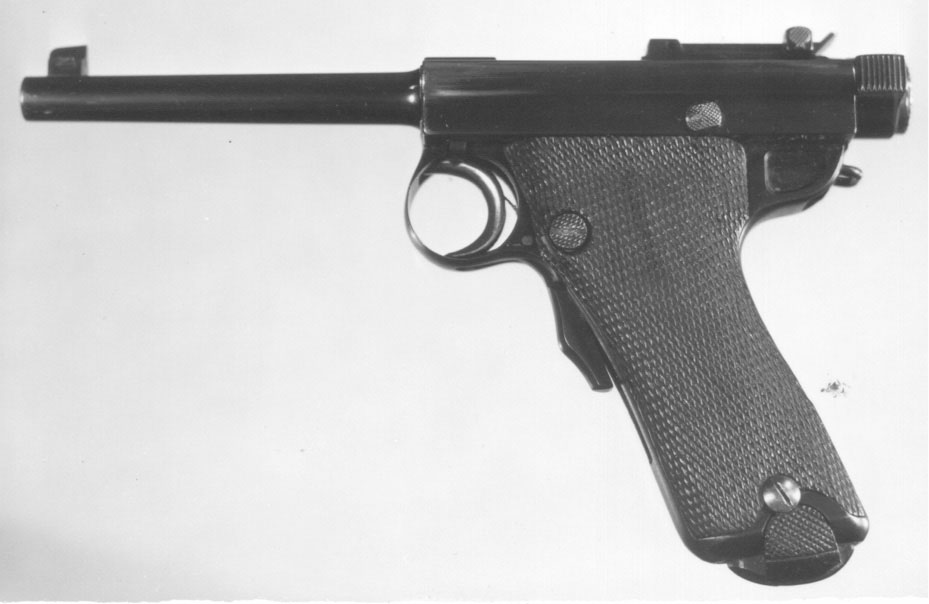
Grandpa • Courtesy of James Rankin
Exc. |
V.G. |
Good |
Fair |
9000 |
7500 |
5000 |
2200 |
NOTE: Add $1,500 for original matching shoulder stock-holster.
Papa
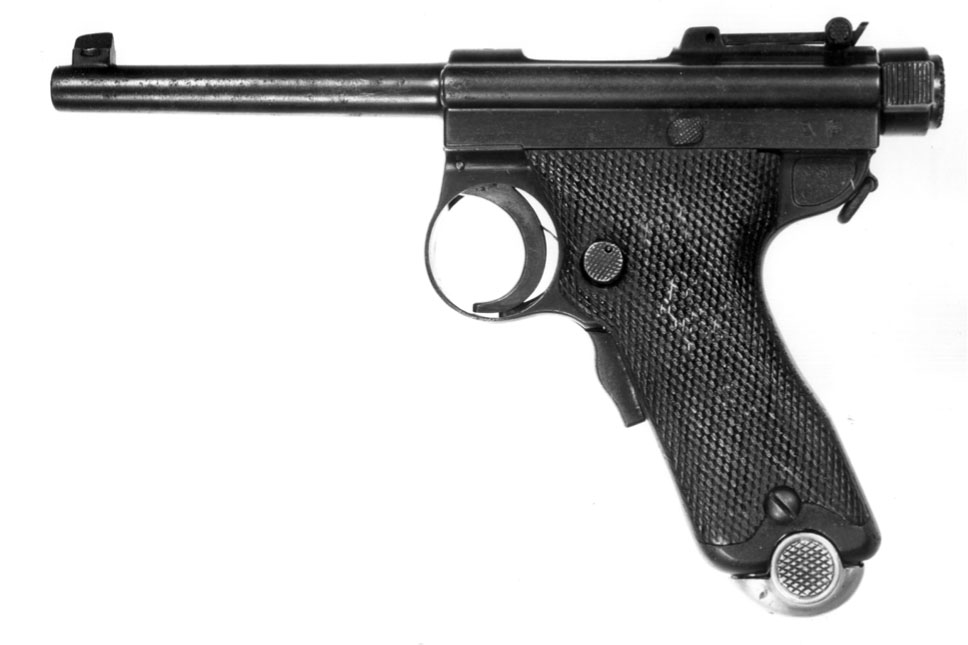
Papa • Courtesy of James Rankin
Exc. |
V.G. |
Good |
Fair |
2800 |
1800 |
1200 |
900 |

Holster for Papa Nambu
Leather construction. Clamshell type. Similar to the more common Type 14 holster. The major difference is that the Papa holster has cartridge loops in the pouch on the front. Price range: 500 – 250.
Baby Nambu
As above, with a 3.5” barrel. 7mm cartridge is unique to the gun. A much smaller version of the Papa 8mm pistol. It is a well-made piece. Production ceased in 1927 with about 6,500 pistols produced.
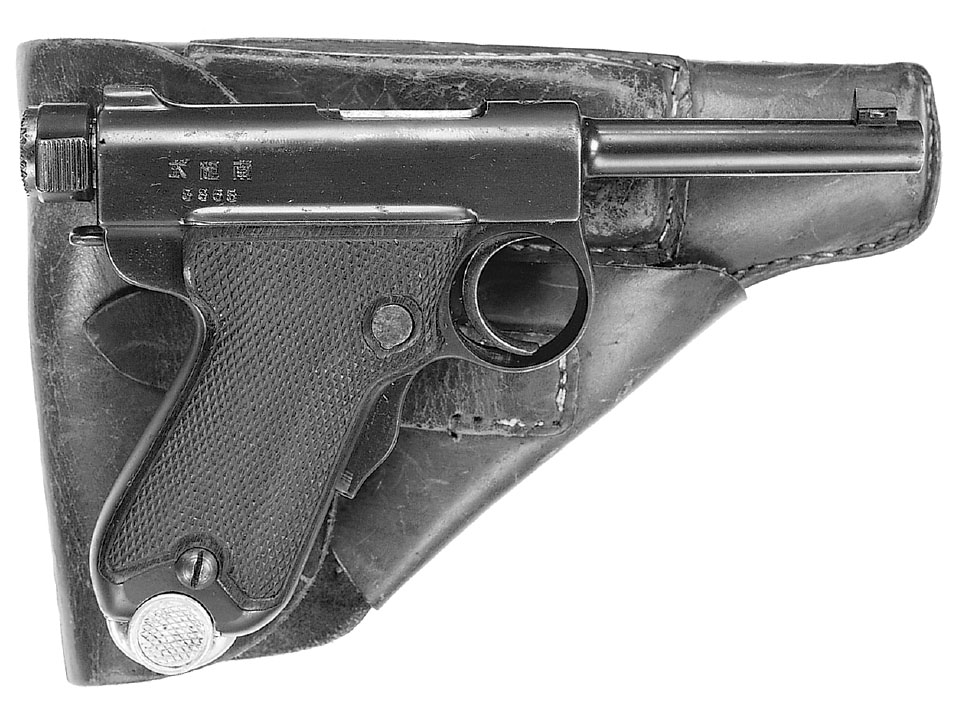
Courtesy Rock Island Auction Company
Exc. |
V.G. |
Good |
Fair |
4800 |
3500 |
2500 |
1000 |
14th Year Type Nambu Pistol/T-14
Similar to the 4th Year Type but without a grip safety and with grooved grips and a larger triggerguard. Manufactured until 1945. Early guns have a small triggerguard. Later models have a much larger triggerguard. Early guns will bring a premium of 20 percent. The month and year of production are indicated on the right side of the receiver, just below the serial numbers on both the Type 14 and Type 94 pistols. The guns are dated from the beginning of the reign of Hirohito (Sho-wa period), which started in 1925. Thus 3.12 means 1928-Dec. and 19.5 means 1944-May.
From 1926 to 1939 (small triggerguard) about 66,700 pistols were manufactured. From 1939 to 1945 (large triggerguard) approximately 73,000 pistols were produced.

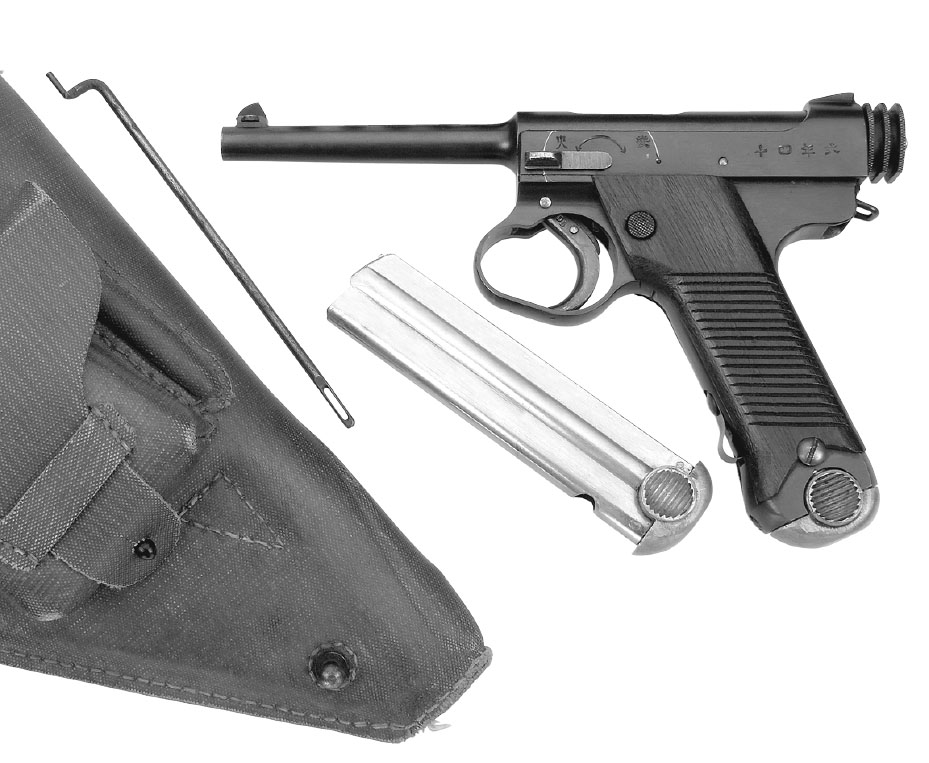
This example features the later large trigger guard • Courtesy Michael Wamsher, Paul Goodwin photo
T-14 pistol and rig with matching magazines.

Type 14 8mm Nambu magazines. Price range 150-60
Courtesy Orvel Reichert
Exc. |
V.G. |
Good |
Fair |
650 |
450 |
375 |
250 |
Holster for Type 14 Nambu
Clamshell style. Made from leather or rubberized canvas. Most were issued with a carrying strap.
Price range: 350 – 100
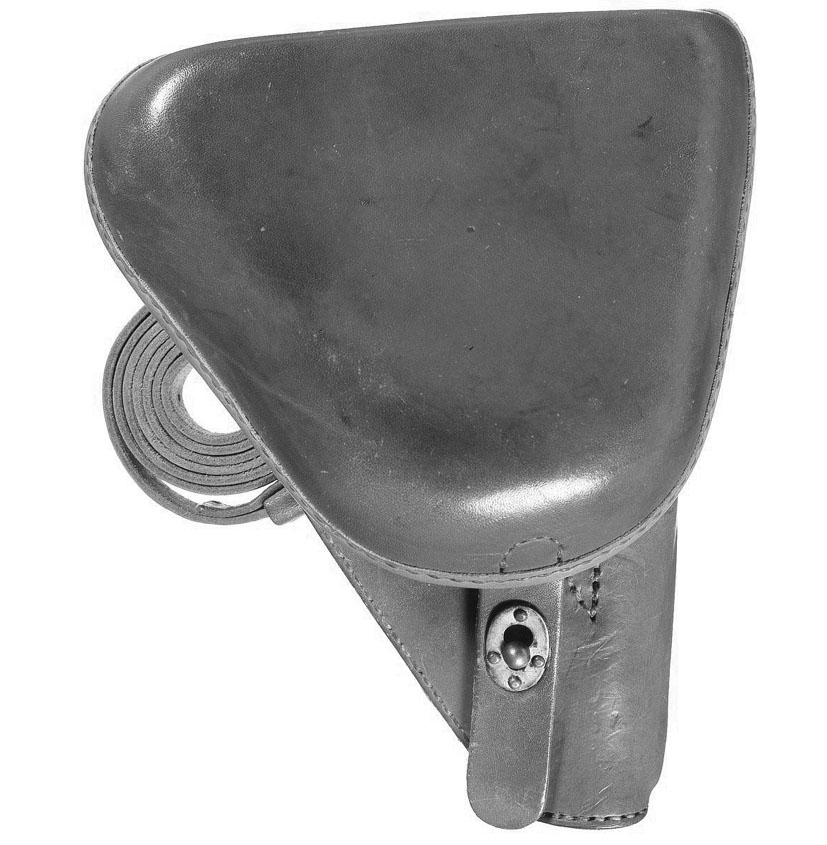
Type 94 Pistol/T-94
An 8mm caliber semi-automatic pistol with a 3.8” barrel and 6shot magazine. Weight is about 27 oz. This was a secondary service pistol issued in WWII. Most late-war examples are poorly constructed and finished. Manufactured from 1935 to 1945. Approximately 70,000 of these pistols were produced.
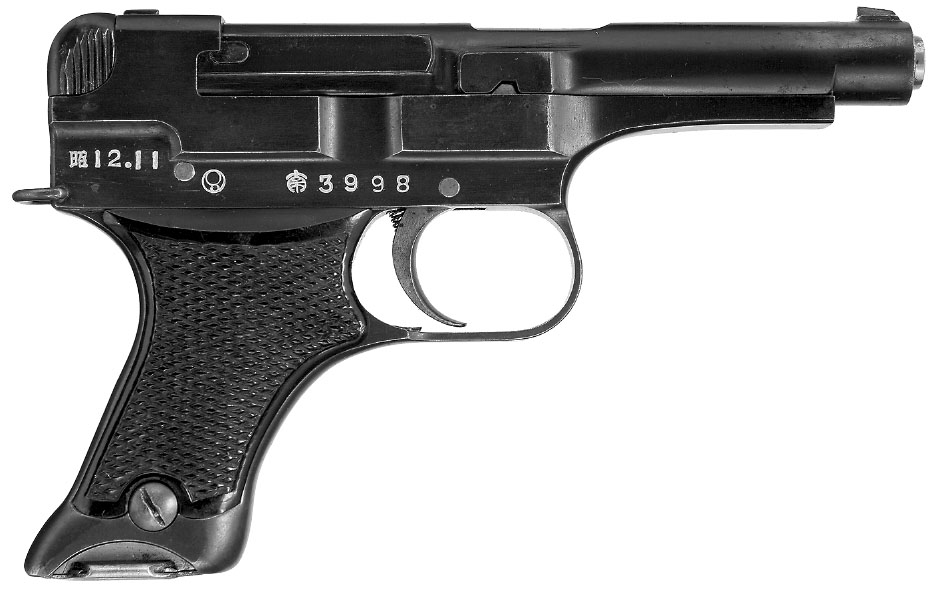
Courtesy Rock Island Auction Company

Courtesy James Rankin

Magazine for Type 94 Nambu. Price 75-40
Exc. |
V.G. |
Good |
Fair |
500 |
375 |
275 |
175 |
Holster for Type 94 Pistol
Leather construction with magazine pouch on front.
Price range: 175 – 75

Hamada Skiki (Type) 2
Designed in 1942. There were several variations of this pistol chambered for both 7.65mm and 8mm Nambu. Production started in 1942 and ended in 1945. Probably fewer than 1,500 pistols were assembled. Rare.
Exc. |
V.G. |
Good |
Fair |
5000 |
3500 |
2500 |
2000 |
The Japanese military used Bergmann submachine guns built by SIG. These guns were similar to the MP 18 but chambered for the 7.63 Mauser cartridge and used a box magazine. These guns were fitted for a bayonet. It was not until the late 1930s that the Japanese began a development program to produce their own submachine gun; the first one was the Type 100/40.
Type 100/40
Adopted for use in 1940, this submachine gun is chambered for the 8×21mm Nambu cartridge and fitted with a 9” barrel with perforated jacket, fitted with a bayonet bar. It is mounted on a wooden half stock with tubular receiver made at the Kokura arsenal. These guns will also be seen with a folding stock made at the Nagoya arsenal. It is estimated that some 10,000 guns were built with fixed stocks and about 6,000 were built with folding stocks. Both types had 30-round box magazines. Rate of fire is approximately 450 rounds per minute. Weight was about 7.5 lbs. This model was issued primarily to paratroopers.
-TN_fmtb1.jpg)
Japanese Type 100/40 • Courtesy Thomas Nelson, World’s Submachine Guns, Vol. I
Pre-1968
Exc. |
V.G. |
Fair |
18000 |
15000 |
10000 |
Type 100/44
This model was first produced in Japan in 1944. It is chambered for the 8mm Nambu cartridge. The barrel is 9.2” long with a honeycombed barrel jacket without bayonet bar. The side-mounted magazine capacity is 30 rounds. Markings are in Japanese on the rear of the receiver. Produced until the end of the war. Weight is about 8.5 lbs. Rate of fire is 800 rounds per minute. Approximately 8,000 were produced at the Nagoya arsenal. This improved version was issued to the infantry.



Pre-1968
Exc. |
V.G. |
Fair |
18000 |
15000 |
10000 |
Type 100 Bayonet
This bayonet was made for use on the Type 100 sub-machine gun and the Arisaka paratrooper rifles. Wood grips. Muzzle ring. No quillon. 7.75” single edge blade. The single maker was Toyoda Loom Co, under Nagoya supervision. The maker’s mark appears on the top of the tang, instead of on the ricasso. These have been faked. Beware! Price range 1800 – 1000.
Bibliographical Note: For historical information, technical data and photos see Military Rifles of Japan, 4th edition. Fred Honeycutt Jr., 1993.
The earliest firearms made by Japan were match lock muskets. These were used in limited quantities through the 1860’s. Prior to the 1870s Japan acquired several models of percussion rifles from foreign sources. These include English, French and Dutch models. See listings under country of origin. Japanese marked examples will bring 25-100% more from collectors.
Japanese Manufactured Match Lock (Tanegashima)
Produced from the mid 1500’s until the 1870s. Manufacture was not standardized and a variety of types have been observed. Price listed here is for common grade examples. Highly engraved versions with gold inlay can bring many times what plain guns do.

Exc. |
V.G. |
Good |
Fair |
Poor |
2500 |
1600 |
1100 |
750 |
500 |
Japanese Manufactured Enfield 1855
The Koishikowa arsenal in Tokyo was founded in 1870. At that time, the Japanese began production of a copy of the English Pattern 1855 Enfield Musket in .577 caliber. It featured a 39-inch barrel, a rifled bore and rifle sights. Made from 1870-1880 it was replaced by the Murata Type 13 series.
Exc. |
V.G. |
Good |
Fair |
Poor |
2000 |
1500 |
950 |
650 |
350 |
Model 1874 Peabody-Martini Rifle
Chambered for the .45 Turkish centerfire cartridge and fitted with a 32.5” barrel. Blued barrel and furniture with case hardened or blued receiver. Numbered in Arabic script. About 7,000 built for Japanese Navy.
Exc. |
V.G. |
Good |
Fair |
1500 |
1250 |
1000 |
750 |
This series of Japanese military rifles was designed by Major Tsuneyoshi, superintendent of Japanese small arms in the late 1870s. These first single-shot bolt- action rifles were based on the French Gras design. Later, Murata was influenced by the French Lebel with its tubular magazine. These rifles were built at the Imperial arsenal in Tokyo.
Murata Type 13 (M.1880)
This was the first Japanese-designed bolt action rifle. This was a single-shot rifle with no extractor or safety. Chambered for the 11×60Rmm cartridge with a barrel length of 31.25”. One piece full-length stock with two barrel bands. The machinery to build this rifle was purchased from Winchester. The rear barrel flat is stamped with the Imperial chrysanthemum. The left side of the receiver is stamped with Japanese characters.
Exc. |
V.G. |
Good |
Fair |
22200 |
1500 |
1000 |
600 |
Murata Type 16
Same as above but fitted with a 25” barrel for cavalry use.
Exc. |
V.G. |
Good |
Fair |
2500 |
1650 |
1200 |
700 |
Murata Type 18 (M.1885)
An 11mm caliber bolt-action rifle with a 31.25” barrel, and full-length stock secured by two barrel bands. This was an improved version of the Type 13, which added receiver gas escape ports, a flat-top receiver ring, and a safety. These rifles were used in the Sino-Japanese War of 1894 and the Russo-Japanese War as well.

Courtesy Buffalo Bill Historical Center, Cody, Wyoming
Exc. |
V.G. |
Good |
Fair |
2000 |
1200 |
800 |
500 |
Bayonet for Type 18 Murata
Wood grips. Muzzle ring. Hook quillon. 18” single edge blade. Has the Imperial Chrysanthemun mark on the cross piece. Steel tipped leather scabbard. Rare. Price range 700 – 400.
Murata Type 22 (M.1889)
Produced circa 1889-1899 in caliber 8×53Rmm. Fitted with a 29.50” barrel with 8-round tubular magazine located in the forearm. This model was full stocked to the muzzle with straight grip. There were two variations of this rifle. The early version had a barrel band forward of the forend band. In the later version, this extra band was eliminated. This was Japan’s first smokeless powder military rifle and was the standard rifle issued to Japanese forces in the Sino-Japanese War of 1894. It remained in service until the Russo-Japanese War of 1904. Weight is about 8.7 lbs.

Courtesy Rock Island Auction Company


Type 100 Bayonet


Bayonet for Type 18 Murata
Exc. |
V.G. |
Good |
Fair |
2000 |
1400 |
1000 |
500 |
Bayonet for Type 22 Murata
Wood grip. Muzzle ring. Hook quillon. 10.9” single edge blade. Has the Imperial Chrysanthemum mark on the cross piece. There are two versions of this bayonet. The difference is in the length of the handle. Type 1 has a 3” handle and type 2 has a 3.75” handle. Steel scabbard. Rare. Price range 700 – 400.
Murata Type 22 Carbine
Introduced in 1894 and fitted with a 19.5” barrel and 5-round magazine. No bayonet fitting. A rare carbine.

Courtesy Richard M. Kumor Sr.
Exc. |
V.G. |
Good |
Fair |
2500 |
1900 |
1400 |
750 |
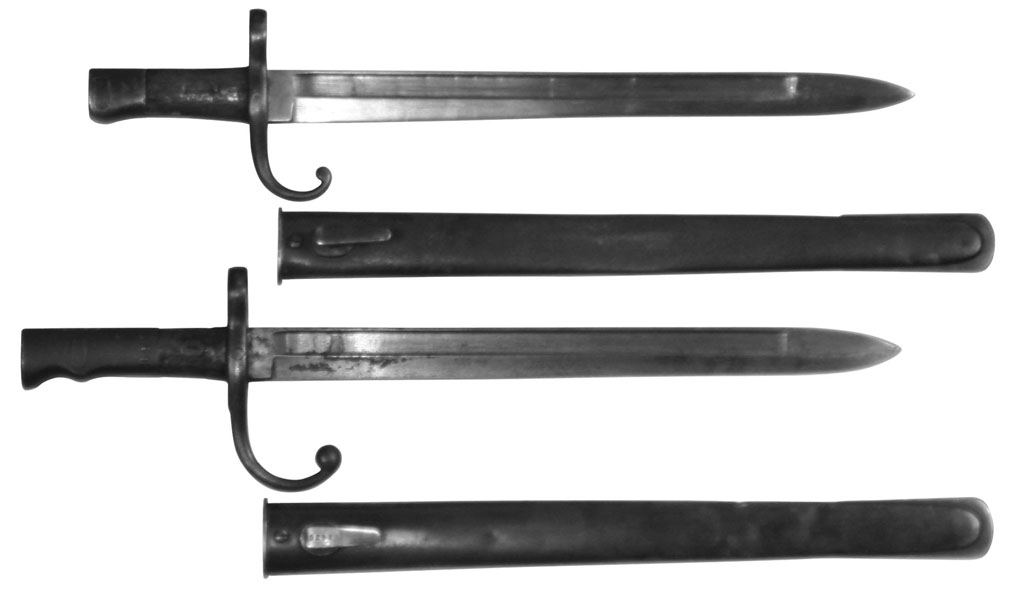
Bayonet for Type 22 Murata
This series of Japanese military rifles was developed by Colonel Nariake Arisaka, Superintendent of the Tokyo Arsenal. His task was to find a replacement for the Murata rifles that showed some defects during the Sino-Japanese War of 1894.
A note about the chrysanthemun marking on Arisaka rifles and carbines:
All Arisaka rifles and carbines were manufactured with the Imperial Chrysanthemum, or mum, on the receiver above the Japanese characters indicating the type of rifle. This is the symbol of ownership by the emperor. The only exceptions are rifles made for non-military use or foreign contracts. The mum was usually ground off, or had file marks cut through it, on rifles when they were surrendered at the end of WWII. There are various accounts as to why it was done and who removed them but the end result is that many Arisakas seen in the U.S. have the mum removed or damaged. The common belief is that a rifle with an intact mum is a battlefield captured weapon, taken before anyone could destroy the mum. An Arisaka with an intact mum can sell for as much as twice the amount of one with mum removed. The prices given here are for Arisakas with an intact mum. Deduct 25 to 50 percent for rifles without the mum.




Japanese Type 30 Carbine • Courtesy West Point Museum, Paul Goodwin photo
Arisaka Type 30 Rifle (aka Hook Safety) (M.1897)
A 6.5×51SRmm Arisaka caliber bolt action rifle with a 31.5” barrel, 5shot magazine and full-length stock secured by two barrel bands and a wooden upper handguard. This was the first box-magazine Mauser-Mannlicher design used by the Japanese military. Straight handle bolt. This was the primary shoulder arm of Japanese troops during the Russo-Japanese War of 1904. Some of these rifles remained in service until WWII. A number of these rifles were sold to Great Britain and Russia during World War I. The Type 30 was also built for Siam (Thailand) and marked by that country’s crest on the receiver bridge. It was designed by Nariaki Arisaka. Manufactured from 1897 to 1905. The rifle gets its nickname, “hook-safety,” from the prominent hook projecting from the left side of the rear of the bolt.

Courtesy Richard M. Kumor Sr.

Courtesy Richard M. Kumor Sr.
Exc. |
V.G. |
Good |
Fair |
900 |
700 |
500 |
300 |
Arisaka Type 30 Carbine (aka Hook Safety Carbine)
As above, with a 20” barrel and no upper handguard.
Exc. |
V.G. |
Good |
Fair |
900 |
700 |
500 |
300 |
Arisaka Type 35 Navy (M.1902)
Adopted by the Japanese navy in 1902, this was an improved version of the Type 30 rifle. Some main differences are that the hook safety was reduced in length and checkered. The receiver included a spring-latched bolt cover. Used during the Russo-Japanese War of 1904. About 40,000 were built. Many of these were sold to Great Britain and Russia during World War I. All dimensions are the same as the Type 30 rifle.
Exc. |
V.G. |
Good |
Fair |
800 |
600 |
450 |
250 |
Arisaka Type 38 Rifle (M.1905)
A 6.5mm Arisaka caliber bolt action rifle with a 31.5” barrel, 5shot magazine and large bolt handle. Full-length stock secured by two barrel bands with finger grooves. Weight is about 9 lbs. It was based on the Model 1893 Spanish Mauser. This rifle saw extensive use as late as World War II. Manufactured from 1905 to 1945. Most production switched to the Type 99 in 7.7mm beginning in 1939. This model was built at the Koishikowa, Kokura, Nagoya, and Mukden arsenals. This model was the first issued with a simple sheet steel dust cover that slides in grooves in the receiver. The bolt handle sticks through an opening in the cover and the cover moves with the bolt when operated. The dust cover is frequently missing, as it is easy to re-insert the bolt in the action without it. Some of these rifles were made in 7mm Mauser. They were made for Mexico and have the Mexican crest of the receiver. See: Mexico for a listing of this variation.



Japanese Type 35 rifle with close-up of breech and hook safety •Private collection, Paul Goodwin photo
The Japanese Arisaka Type 38, 44 and 99 rifles have a following of dedicated collectors. Many will pay prices much higher than those listed in this book for original, matching specimens. There are many factors that determine the desirability of a particular rifle. There is not room in this book to go into the fine detail needed to determine whether a given rifle will be one of the high-price examples. Some of the things that a collector will look for include intact mum, arsenal of manufacture, series and matching numbers. An intact mum is explained at the beginning of this section.
I will attempt to briefly describe what to look when collecting Arisakas. Japanese rifles are a hard field to explain to those not familiar with the following minor differences.
On the left side of the receiver are the serial number and an arsenal mark. A list of arsenal marks is shown in this section. Some arsenals made more rifles than others. A series mark is a Japanese character in a circle next to the arsenal mark. Early production Arisakas did not use a series mark.
The practice of using series marks started in the 1930s. There were over 30 series marks used. There is not enough room to show them here. There would be SN: 1 to 10,000 of a series made then a new mark was used. Each arsenal used its own block of series marks.

Here are arsenal markings for Japan’s Arisaka rifles. No. 1 was used for Tokyo’s Koishikawa Arsenal (1870-1935) and the Kokura Arsenal (1935-45). The other arsenal locations and dates are: 2) Nagoya Arsenal, 3) Jinsen Arsenal (Korea) and 4) Mukden Arsenal (Manchuria). Paired markings indicate the supervising arsenal (Kokura or Nagoya) and a second symbol representing the manufacturing company: 5) Tokyo Kogyo, 6) and 7) Tokyo Juki Kogyo, 8) Howa Jyuko and 9) Izawa Jyuko.
Numbering Practices
Early production rifles used a three-digit assembly number that is located on the underside of the receiver. Parts were matched to the assembly number, not the serial number. Several other parts can be numbered internally as well. The gun must be dis-assembled to see them. Most sellers will not allow this to be done. If the bolt parts, floor plate and bayonet lug match, it is a somewhat safe bet that the assembly number is the same and the rifle can be called matching. Occasionally, some parts will match the serial number visible on the left side of receiver with others matching the hidden assembly number. Confusing, huh? If there are more than two numbers present (serial and assembly), it can be assumed that the rifle is mismatched. In later production, all parts are matched to the serial number. All but the earliest Type 99s are numbered to match the serial number. Type 99s do not have a numbered floor plate.
There is no set percentage of price to deduct if an Arisaka is mismatched. Few mismatched guns will bring the Excellent or Very Good price, regardless of condition.
So why did I add this information? Just to inform sellers and buyers how to tell if their Arisaka might be in the high-dollar category and therefore justify further research. I suggest using the Honeycutt book and consultation with knowledgeable collectors. Good luck!
Phillip Peterson

Arisaka Type 38 Rifle •Courtesy West Point Museum, Paul Goodwin photo
Exc. |
V.G. |
Good |
Fair |
600 |
450 |
250 |
175 |
NOTE: Price assumes an intact MUM and correctly matching numbers. See the Collector Spotlight on Arisaka rifles for numbering practices. Deduct 25-50% for ground mum or miss match.

Courtesy Richard M. Kumor Sr.

Courtesy Richard M. Kumor Sr.
Arisaka Type 38 Carbine
As above, with a 19” barrel and upper handguard. Equipped for a bayonet. Weight is about 7.25 lbs.
Exc. |
V.G. |
Good |
Fair |
650 |
474 |
300 |
175 |
Thai Type 38 Conversions
Short Rifle .30-06
Exc. |
V.G. |
Good |
Fair |
600 |
475 |
350 |
250 |
Half-Stock Carbine 6.5mm
Exc. |
V.G. |
Good |
Fair |
550 |
425 |
300 |
200 |
Manchurian Mauser Rifle (Mukden Arsenal)
This rifle has many features from both the Mauser 98 and the Arisaka. Barrel length is 29” and most rifles are chambered for the 7.92×57mm cartridge while some are chambered for the Japanese 6.5mm cartridge. Magazine capacity is 5 rounds. Bolt handle is pear shaped. Marked on top of receiver ring with Mukden arsenal symbol.

Exc. |
V.G. |
Good |
Fair |
700 |
550 |
400 |
250 |

Type 44 Carbine • Courtesy Rock Island Auction Company
Arisaka Type 44 Carbine
Similar to the Type 38 carbine but with an 18.5” barrel and folding bayonet that hinged into the forearm. Weight was about 9 lbs.
Exc. |
V.G. |
Good |
Fair |
1000 |
750 |
550 |
300 |
NOTE: Price assumes an intact mum and correctly matching numbers. See the “Collector Spotlight” on Arisaka rifles for numbering practices. Deduct 25-50 percent for ground mum or mismatch.
Arisaka Type 97 “Sniper’s Rifle”
The Type 38 with a side-mounted 2.5-power telescope and a bipod. Introduced in 1937. The telescope mounted on each rifle was factory fitted and stamped with the serial number of the rifle. The rear sight was a peep with folding from 400 to 2,200 meters. Weight is approximately 11 lbs. with scope. Deduct 50 percent for a sniper rifle missing the scope.
Exc. |
V.G. |
Good |
Fair |
4000 |
2500 |
1200 |
600 |
Arisaka Type 99 Short Rifle
This model is an improved version of the Type 38 rifle. A 7.7mm caliber bolt action rifle with a 26” barrel and full-length stock secured by two barrel bands. Non-detachable magazine capacity is 5 rounds. Fitted with a folding wire monopod. Weight is about 8.5 lbs. Adopted for military use in 1939. The rear sight on this rifle was a graduated leaf-type with folding arms to help aiming at aircraft. Parts such as floor plate, butt plate, bolt cover, and swivel bands were made from metal stampings.The monopod and anti-aircraft sight were phased out as the war progressed. The first use of this model in combat against U.S. forces was during the Battle of Guadalcanal beginning in August, 1942.


Mukden Arsenal Mauser •Private collection, Paul Goodwin photo




Japanese WWll Type 97 Sniper with close-up of scope and markings. All numbers match. Notice full “Mum” •Courtesy Michael Wamsher, Paul Goodwin photo
Exc. |
V.G. |
Good |
Fair |
500 |
375 |
250 |
125 |
NOTE: Price assumes an intact mum and correctly matching numbers. See the “Collector Spotlight” on Arisaka rifles for numbering practices. Deduct 25-50 percent for ground mum or mismatch. Add 15 percent for monopod.
Arisaka Type 99 Long Rifle
This variation is the same as the above model but fitted with a 31.4” barrel. Weight is about 9 lbs. This is a scarce variation.
Exc. |
V.G. |
Good |
Fair |
750 |
550 |
450 |
175 |
NOTE: Price assumes an intact mum and correctly matching numbers. See the “Collector Spotlight” on Arisaka rifles for numbering practices. Deduct 25-50 percent for ground mum or mismatch. Add 30 percent for monopod and dust cover.
Type 30 Bayonet
This bayonet was made for use on all Arisaka rifles and carbines except for the Type 44. It also was used on the Type 96 and 99 light machine guns. The only WWII case where a machine gun could mount a bayonet. Wood grips. Muzzle ring. Some have a hook quillon, others do not. 15.75” single edge blade. Some have a blued blade, others will be polished white. Made by four arsenals: Kokura, Nagoya, Mukden and Jinsen. Also several contractors working under supervision of Kokura or Nagoya. The quality of finish and manufacturing declined as WWII progressed. Late war examples do not have a fuller in the blade and were issued with a wooden scabbard. Price range 175 – 40.


Japanese Type 99 Short Rifle 7.7mm

Courtesy Rock Island Auction Company

Arisaka Flag Pole
This interesting item is included here because it attaches to the bayonet lug of the Arisaka rifles. The owner of the pictured item knows of only a handful in U.S. collections. Price estimation of 2000 – 1000.


Type 30 Bayonets

Arisaka Flag Pole, image courtesy Larry Brown collection


Flag Pole Bayonet, image courtesy Larry Brown collection

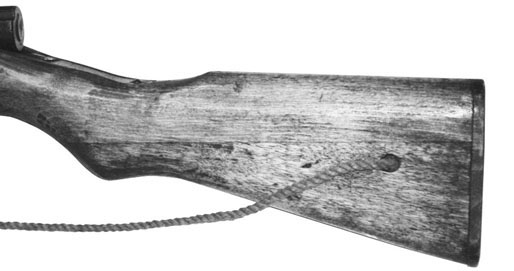
Arisaka Type 99 “Last Ditch” Rifle, image courtesy Larry Brown collection
Pole Bayonet
Wood handle. No pommel or rifle mounting fixtures.15.2” single edge blade. Late war wood scabbard. Example shown has a Jinsen arsenal marking. This is not actually a bayonet but is made with a bayonet blade, so it is included here. It was a last-ditch weapon intended to mount on a wood or metal pole. The idea was to stab an enemy soldier and take his rifle. Price range 600 – 250.
Arisaka Type 99 “Last Ditch” Rifle
This is a Type 99 simplified for easier production. Typical features include a cylindrical bolt knob, a fixed peep sight, no front sight guards and a wooden buttplate. Not all rifles have each of these features. Some last ditch rifles have a hole in the stock instead of a sling swivel. The hole is for using a piece of rope as a sling. Add 25 percent for a rope sling rifle.
Exc. |
V.G. |
Good |
Fair |
350 |
250 |
200 |
125 |
NOTE: Price assumes an intact mum and correctly matching numbers. See the “Collector Spotlight” on Arisaka rifles for numbering practices. Deduct 25-50 percent for ground mum or mismatch.
Test Type 1 Paratroop Rifle
Bolt action rifle chambered for 6.5mm Japanese. Barrel length is 19”. Cleaning rod is 17 3/16” long. The stock is a two-piece buttstock with full-length handguard and a hinge attached at the wrist. Metal finish is blued. Total number produced is approximately 200-300 rifles.
Exc. |
V.G. |
Good |
Fair |
3000 |
2500 |
2000 |
1200 |
Type 100 Paratroop Rifle
Chambered for 7.7mm Japanese cartridge. Barrel length is 25-1/4” long. Blued cleaning rod 21-5/16” long. Rear sight is adjustable from 300 to 1500 meters. Two-piece buttstock with full handguard can be disassembled with an interrupted-thread connector. Bolt handle is detachable. Metal finish is blued. Total number produced is estimated at 500 rifles.
Exc. |
V.G. |
Good |
Fair |
4500 |
4000 |
3000 |
1500 |
Type 2 Paratroop Rifle
Similar to the model above but with a different style of takedown. This model uses a wedge and bail wire connector. This rifle production began in late 1943.
Exc. |
V.G. |
Good |
Fair |
2500 |
1850 |
1200 |
500 |
NOTE: Price assumes an intact MUM and correctly matching numbers. See the Collector Spotlight on Arisaka rifles for numbering practices. Deduct 25-50% for ground mum or miss match.
Type 99 “Sniper’s Rifle”
The standard Type 99 with a 25.5” barrel and either a 2-1/2 power or 4-power telescope. Deduct 50 percent for a sniper rifle missing the scope.
Exc. |
V.G. |
Good |
Fair |
3000 |
2500 |
1800 |
1200 |
NOTE: The 4× scope is more rare than the 2-1/2 power scope. For 4x scope add $500.
Type 5 Semi-automatic Rifle
A 7.7mm semi-automatic rifle with a 10-round box magazine patterned after the U.S. M1. Made at the Kure Naval Arsenal in 1945. It is believed that approximately 20 were made. Prospective purchasers should secure a qualified appraisal.

Courtesy Richard M. Kumor Sr.


Japanese Type 2 Paratroop Rifle •Amoskeag Auction Company


Type 99 with 4× external scope •Courtesy private collection, Paul Goodwin photo


Type 99 with 2-1/2 power scope •Courtesy private collection, Paul Goodwin photo

Action of a Type I Rifle, made in Italy
Exc. |
V.G. |
Good |
Fair |
22000 |
19000 |
14000 |
7500 |
Type I
Made in Italy, this is a Carcano action coupled with an Arisaka magazine system. Appears similar to the Type 38 rifle. Made under contract in the 1930’s. Type I’s have no receiver markings except for the serial number.
Exc. |
V.G. |
Good |
Fair |
350 |
275 |
200 |
150 |
G 71 Rifle
This is the same rifle as built for the German Empire. Chambered for the 11×60mm cartridge and fitted with a 33.5” barrel. Full stocked. Single shot. Weight is about 10 lbs.
Exc. |
V.G. |
Good |
Fair |
1250 |
900 |
750 |
300 |
Japanese Training Rifle
Made for training of military recruits and school students. A “non-gun” copy of the Arisaka Type 38 or Type 99 Long Rifle. Not safe to fire. Many were brought home as war souvenirs. These are frequently confused with real rifles by the u-informed. The trainers have no mum, model or arsenal markings. They have a serial number on the receiver and bolt. Some have a maker’s logo.
Exc. |
V.G. |
Good |
Fair |
175 |
150 |
100 |
50 |
The Japanese used the Hotchkiss gun during the Russo-Japanese War and later adopted the Model 1914 Hotchkiss. Both of these guns were chambered for the 6.5mm cartridge.
Japanese Type 1
Introduced in 1941 as an improvement over the Type 92. Barrel length is 23” with cooling fins the same diameter through its length. The muzzle is fitted with a flash hider. Fed by a 30-round metal strip and chambered for the 7.7mm cartridge. Rate of fire is approximately 550 rounds per minute. Weight is about 77 lbs. with tripod.
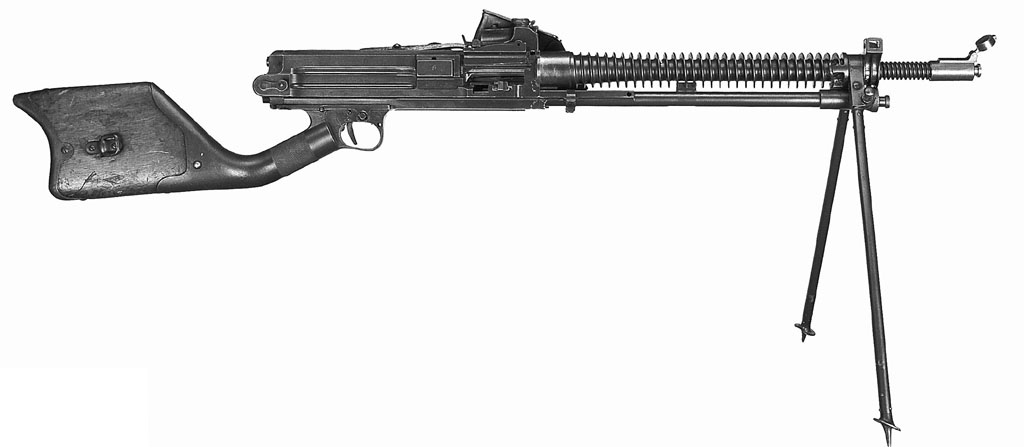

Japanese Type 11 •Courtesy private NFA collection, Paul Goodwin photo
NOTE: Many of these guns were not stamped “Type 1” but instead “Type 92.” The finned barrel is the key feature.
Pre-1968
Exc. |
V.G. |
Fair |
14000 |
12500 |
11000 |
Japanese Type 3
Medium air-cooled gun chambered for 6.5×51SR Arisaka cartridge and introduced in 1914. The Hotchkiss Model 1897 influenced the design of this gun. Cooling fins on the barrel. Spade grips and tripod mount with sockets for carrying poles. Weight was about 63 lbs. Barrel length was 29.5”. Fed from a metal 30-round strip. Rate of fire was about 400 rounds per minute. Introduced in 1914.
Pre-1968
Exc. |
V.G. |
Fair |
12000 |
10000 |
9000 |
Japanese Type 11
First produced in 1922, this is a light air-cooled machine gun chambered for the 6.5×51SR Arisaka cartridge. The gun utilizes a 30-round hopper feed system. The 19” barrel is finned. Weight is about 22.5 lbs. Rate of fire is 500 rounds per minute. Fitted with a bipod. This was the most widely used machine gun by the Japanese military during combat in China between 1937 and 1939.
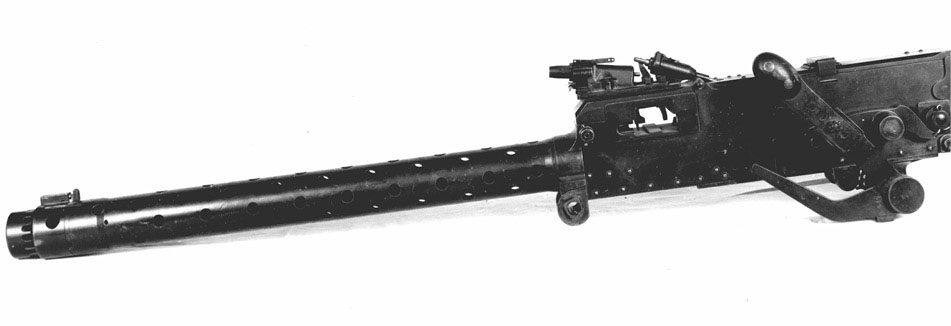
Japanese Type 89 Vickers Aircraft • Courtesy Blake Stevens
Pre-1968
Exc. |
V.G. |
Fair |
9500 |
8000 |
7000 |
Japanese Type 89
This gun was produced in 1929 and is a copy of the British Vickers aircraft gun but chambered for the 7.7×56R (.303 British) cartridge. Weight is about 27 lbs.
Pre-1968
Exc. |
V.G. |
Fair |
16500 |
15000 |
13000 |

Type 92 on the only known privately held AA mount • Courtesy Robert E. Naess
Japanese Type 92
This is an improved version of the Type 3 gun introduced in 1932. Chambered for the 7.7×58SR cartridge. It was fitted with dropped grips behind and below the receiver instead of spade grips. Barrel length is 28”. Fed by a metal 30-round strip. Rate of fire was about 450 rounds per minute. Weight is about 100 lbs. with tripod. Gun alone weighs approximately 60 lbs. The mount was designed so that two men could carry it by means of poles or pipes fitted into the legs of the mount. This was the most widely used Japanese machine gun of WWII.
NOTE: The Type 92 designation was also applied to the Japanese copy of the Lewis gun. See Great Britain, Machine Guns, Lewis 0.303in, Mark 1.
Pre-1968
Exc. |
V.G. |
Fair |
15000 |
12500 |
10000 |
Pre-1986 manufacture with new receiver or reweld
Exc. |
V.G. |
Fair |
11000 |
10000 |
9000 |
Japanese Type 92 Lewis
This is a licensed copy of the British Lewis gun. Caliber is .303. Built in both ground and aircraft configurations. There are some minor technical differences between the two. Spade grips. The Japanese tripod for this gun is unique to the gun.
NOTE: Prices listed below are for the gun with original Japanese tripod. Deduct $2,500 for no tripod or incorrect tripod.
Pre-1968
Exc. |
V.G. |
Fair |
11000 |
10000 |
9000 |
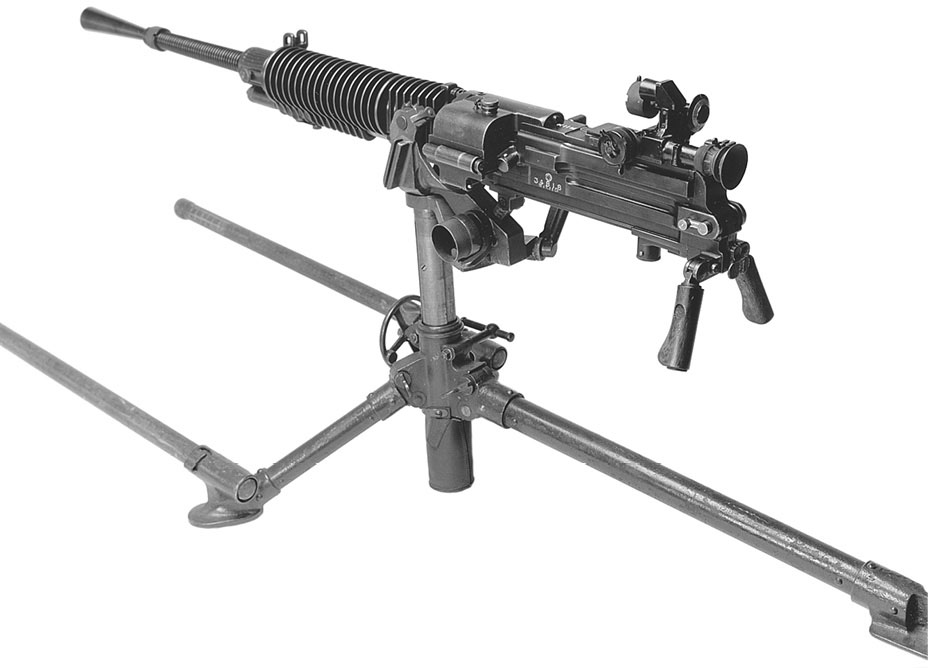
Type 92 • Private NFA collection, Gary Gelson photo
Japanese Type 96
Designed by General Kijiro Nambu and introduced in 1936, this light, air-cooled machine gun is chambered for the 6.5mm cartridge. It was considered an improvement over the Model 11. This model has a top-mounted box magazine with a 30-round capacity. The cartridges are oiled when loaded into the magazine by an oiler built into the magazine loader. Barrel length is a finned 22” quick-change affair with carrying handle. The wood buttstock has a pistol grip. Rate of fire is about 550 rounds per minute. Weight is approximately 20 lbs. These guns are sometimes seen with a 2.5 power scope fitted on the receiver. This was the standard light machine gun of the Japanese military from 1936 to 1939.


Japanese Model 96 with plaque that reads, “Presented to U.S.M.A. by two former superintendents: General Douglas MacArthur and Lt. Gen. Robert L. Eichelberger captured at Buna, New Guinea, Dec. 27, 1942” • Courtesy West Point Museum, Paul Goodwin photo
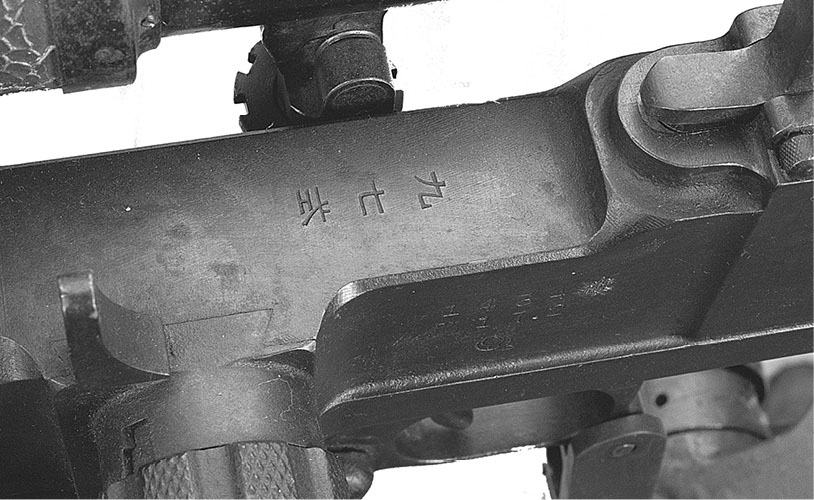

Japanese Type 97 Tank •Courtesy private NFA collection, Paul Goodwin photo
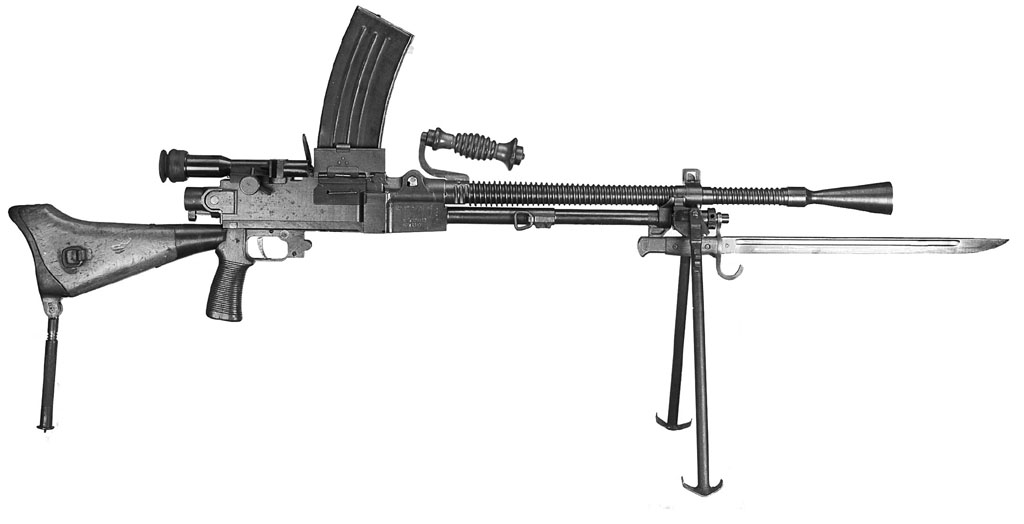
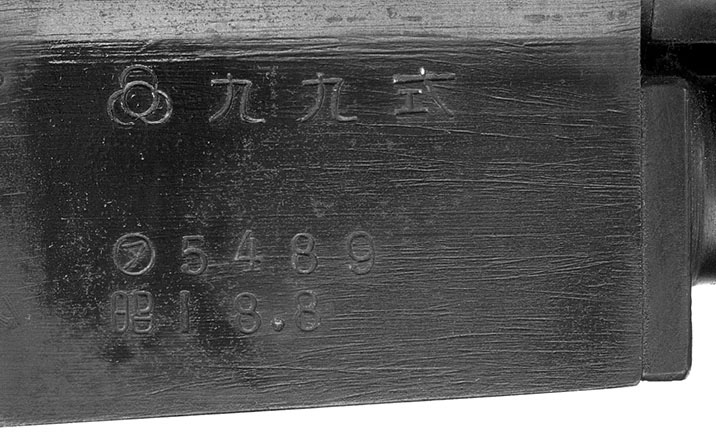
Type 99 •Courtesy private NFA collection, Paul Goodwin photo

Japanese Machine Gun Trainer •Paul Goodwin photo
NOTE: Magazines are scarce.
Pre-1968
Exc. |
V.G. |
Fair |
9500 |
7000 |
4500 |
Japanese Type 97
This model was designed in 1937 to be fired from a tank or aircraft. It was to replace the Type 92 gun and is chambered for the 7.7mm cartridge. Its barrel length is 28” and the barrel is finned for cooling. Design is similar to the Czech VZ26. This was the first Japanese machine gun that did not require oiled ammunition. Weight is about 24 lbs. Rate of fire is approximately 500 rounds per minute. Fed by a 30-round box magazine.
Pre-1968
Exc. |
V.G. |
Fair |
9000 |
7000 |
5000 |
Japanese Type 98
This is a copy of the German MG 15 ground gun. First used in 1938. Fed by a 75-round saddle drum with a rate of fire of 900 rounds per minute.
Pre-1968
Exc. |
V.G. |
Fair |
12000 |
7000 |
5000 |
Japanese Type 99
Chambered for the 7.7×58mm Arisaka cartridge, this machine gun was first produced for the Japanese army in 1939, and is an improved version of the Type 96. Although first produced in 1939 it was not issued until 1942 and first used in combat in 1943. It is fitted with a 21.3” quick change barrel and a 30-round top feed magazine. Its rate of fire is 850 rounds per minute. It weighs about 23 lbs. The gun is marked on the right front side of the receiver with date of manufacture and maker’s symbols. The gun has a bipod under the barrel and a monopod under the toe of the buttstock. Production ceased with the end of WWII.
Pre-1968
Exc. |
V.G. |
Fair |
12000 |
9000 |
5000 |
Japanese Machine Gun Trainer
These guns were built in small machine shops all over Japan in the 1930s and 1940s so that young school-age males could be taught the basic techniques and operations of machine guns. Blowback operation. This gun does in fact fire a reduced load of either 6.5mm or 7.7mm cartridges, as well as blanks and is registered as a machine gun under the NFA. These guns, as a group, are different enough so that no two will be exactly the same. Caution: Do not fire this gun. It is unsafe.
Pre-1968
Exc. |
V.G. |
Fair |
5000 |
4000 |
2500 |